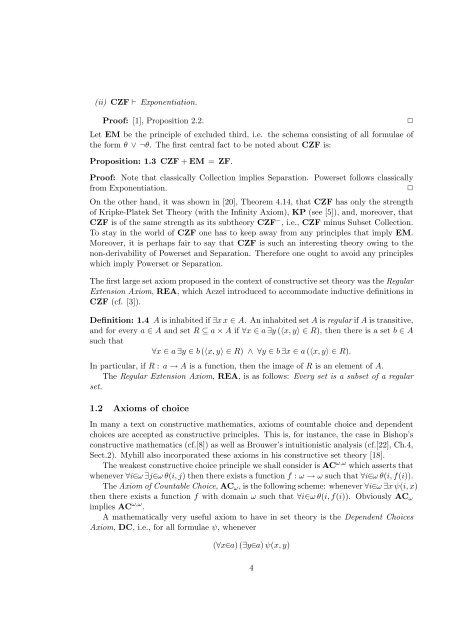Realizability for Constructive Zermelo-Fraenkel Set Theory
Realizability for Constructive Zermelo-Fraenkel Set Theory
Realizability for Constructive Zermelo-Fraenkel Set Theory
You also want an ePaper? Increase the reach of your titles
YUMPU automatically turns print PDFs into web optimized ePapers that Google loves.
(ii) CZF ⊢ Exponentiation.Proof: [1], Proposition 2.2.Let EM be the principle of excluded third, i.e. the schema consisting of all <strong>for</strong>mulae ofthe <strong>for</strong>m θ ∨ ¬θ. The first central fact to be noted about CZF is:Proposition: 1.3 CZF + EM = ZF.Proof: Note that classically Collection implies Separation. Powerset follows classicallyfrom Exponentiation.✷On the other hand, it was shown in [20], Theorem 4.14, that CZF has only the strengthof Kripke-Platek <strong>Set</strong> <strong>Theory</strong> (with the Infinity Axiom), KP (see [5]), and, moreover, thatCZF is of the same strength as its subtheory CZF − , i.e., CZF minus Subset Collection.To stay in the world of CZF one has to keep away from any principles that imply EM.Moreover, it is perhaps fair to say that CZF is such an interesting theory owing to thenon-derivability of Powerset and Separation. There<strong>for</strong>e one ought to avoid any principleswhich imply Powerset or Separation.The first large set axiom proposed in the context of constructive set theory was the RegularExtension Axiom, REA, which Aczel introduced to accommodate inductive definitions inCZF (cf. [3]).Definition: 1.4 A is inhabited if ∃x x ∈ A. An inhabited set A is regular if A is transitive,and <strong>for</strong> every a ∈ A and set R ⊆ a × A if ∀x ∈ a ∃y (〈x, y〉 ∈ R), then there is a set b ∈ Asuch that∀x ∈ a ∃y ∈ b (〈x, y〉 ∈ R) ∧ ∀y ∈ b ∃x ∈ a (〈x, y〉 ∈ R).In particular, if R : a → A is a function, then the image of R is an element of A.The Regular Extension Axiom, REA, is as follows: Every set is a subset of a regularset.1.2 Axioms of choiceIn many a text on constructive mathematics, axioms of countable choice and dependentchoices are accepted as constructive principles. This is, <strong>for</strong> instance, the case in Bishop’sconstructive mathematics (cf.[8]) as well as Brouwer’s intuitionistic analysis (cf.[22], Ch.4,Sect.2). Myhill also incorporated these axioms in his constructive set theory [18].The weakest constructive choice principle we shall consider is AC ω,ω which asserts thatwhenever ∀i∈ω ∃j∈ω θ(i, j) then there exists a function f : ω → ω such that ∀i∈ω θ(i, f(i)).The Axiom of Countable Choice, AC ω , is the following scheme: whenever ∀i∈ω ∃x ψ(i, x)then there exists a function f with domain ω such that ∀i∈ω θ(i, f(i)). Obviously AC ωimplies AC ω,ω .A mathematically very useful axiom to have in set theory is the Dependent ChoicesAxiom, DC, i.e., <strong>for</strong> all <strong>for</strong>mulae ψ, whenever(∀x∈a) (∃y∈a) ψ(x, y)✷4
















